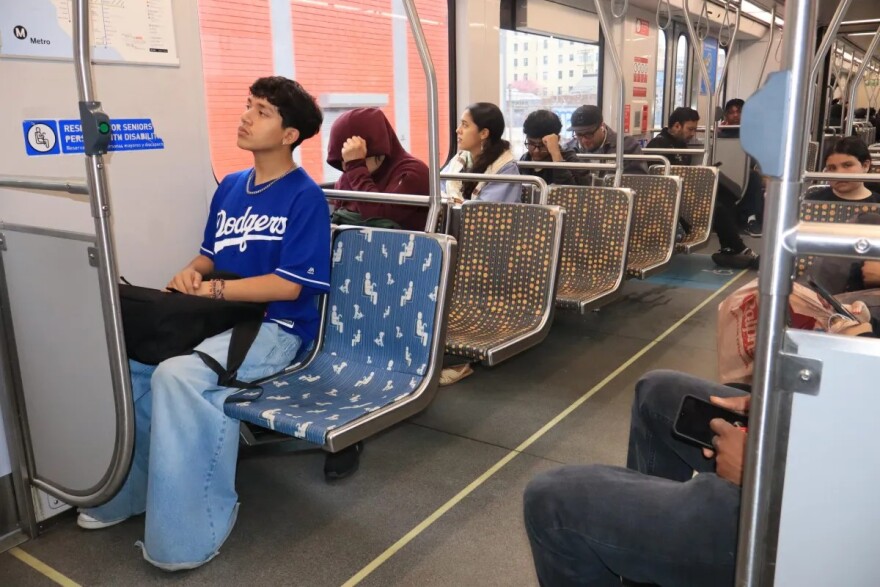Truth matters. Community matters. Your support makes both possible. LAist is one of the few places where news remains independent and free from political and corporate influence. Stand up for truth and for LAist. Make your year-end tax-deductible gift now.
For some LA students, the most dangerous part of the school day is getting home

This story was originally published by Boyle Heights Beat on May 28, 2025.
For David Higuera, the hour-and-a-half commute between South Los Angeles to Roosevelt High School in Boyle Heights does not feel like a safe way to start and end the day.
“Using public transportation, I feel unsafe. It’s unsanitized,” said the 17-year-old. “There’s always crime happening around, and as a student, it feels really dangerous.”
Higuera is not alone. For many Los Angeles Unified School District (LAUSD) high school students who rely on public transportation, including those who stay late at school for extracurriculars, college prep, or sports, getting to and from school can feel like the most dangerous part of their day. With LAUSD school buses ending service by early evening, many students are left without alternatives. This means facing dark train stations, confronting crime, and sometimes carrying self-defense tools. The situation exposes a transportation gap that puts youth at risk.
Higuera rides the Metro Blue and Gold lines home every evening after swim practice and his college prep program. He wishes schools would provide a safer alternative to commuting students like himself.
“I mainly avoid public transportation in South Central,” said Higuera. “Mainly because of the crime rates and certain unsafe areas around there.”
These student concerns are reflected in broader safety trends across the transit system.
In an L.A. Metro report on public safety, there were 1,719 crimes, including non-violent incidents, just between January and March of last year. Crimes include battery, vandalism and trespassing.

In response to incidents of violence and safety issues targeting Metro riders and operators, Mayor Karen Bass has increased law enforcement presence at many L.A. Metro transit stops. As of May of this year, there are 870 officers placed at Metro stations, with only half of those members being armed to respond to crime on the system. The Metro board has also approved the creation of an L.A. Metro police department with the hopes of deploying an additional 1,100 staff, including police officers, by 2029.
But while city officials work to boost safety through staffing and enforcement, public confidence in the city’s Metro system remains low. According to an L.A. Barometer survey conducted by USC researchers last year, over 80% of L.A. residents think riding Metro trains is unsafe — up from 76% in December 2019.
Roosevelt High School student Andrea Quintana said she notices the inconsistency in security across different neighborhoods.
“I feel like coming to Roosevelt on Soto Street, there aren’t necessarily that many people who are taking care of the Metro stop,” she said. “However, at Fig [7th/Metro Center station], there are so many cops in every entryway.”

The Los Angeles Department of Transportation is aware of the safety concerns of students. In an email statement sent to Boyle Heights Beat, a representative said:
“LADOT also works with communities to proactively identify safety improvements. Our staff have met with school principals to learn about the particular needs of a school and taken actions such as moving or installing crosswalks to better serve bus stations based on these conversations.”
As of now, L.A. Metro has over 300 ambassadors who board buses and trains to help increase Metro safety.
But for many young riders, it’s not enough. Higuera said he’s resorted to carrying pepper spray his older sister gave him as a safety precaution, mentioning how her past experiences remind him to stay alert at night.
But because pepper spray is not permitted on school campuses, many students have had their items confiscated.
“They [school administrators] don’t see it as a way to defend ourselves, but more as a way to hurt ourselves or other students,” said Keilly Flores, a senior at Roosevelt High School, who said school rules fail to consider their safety beyond campus grounds.
Michelle León, a high school senior at Felicitas and Gonzalo Mendez, also feels unsafe taking the bus home at night. She said she fears people who are under the influence, as well as the lack of security.
According to a 2019 report by the Los Angeles Metropolitan Transportation Authority, safety was found as the primary barrier to riding transit for women.
“I feel like female students are more prone to harassment and inappropriate behavior while riding public transportation,” said León.







